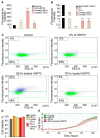Potential of Plant Exosome Vesicles from Grapefruit (Citrus × paradisi) and Tomato (Solanum lycopersicum) Juices as Functional Ingredients and Targeted Drug Delivery Vehicles
- PMID: 37107317
- PMCID: PMC10135875
- DOI: 10.3390/antiox12040943
Potential of Plant Exosome Vesicles from Grapefruit (Citrus × paradisi) and Tomato (Solanum lycopersicum) Juices as Functional Ingredients and Targeted Drug Delivery Vehicles
Abstract
Plant-derived extracellular vesicles (PEVs) have gained attention as promising bioactive nutraceutical molecules; their presence in common fruit juices has increased their significance because human interaction is inevitable. The goal of this study was to evaluate the potential of PEVs derived from grapefruit and tomato juices as functional ingredients, antioxidant compounds, and delivery vehicles. PEVs were isolated using differential ultracentrifugation and were found to be similar in size and morphology to mammalian exosomes. The yield of grapefruit exosome-like vesicles (GEVs) was higher than that of tomato exosome-like vesicles (TEVs), despite the latter having larger vesicle sizes. Furthermore, the antioxidant activity of GEVs and TEVs was found to be low in comparison to their juice sources, indicating a limited contribution of PEVs to the juice. GEVs showed a higher efficiency in being loaded with the heat shock protein 70 (HSP70) than TEVs, as well as a higher efficiency than TEV and PEV-free HSP70 in delivering HSP70 to glioma cells. Overall, our results revealed that GEVs present a higher potential as functional ingredients present in juice and that they exert the potential to deliver functional molecules to human cells. Although PEVs showed low antioxidant activity, their role in oxidative response in cells should be further addressed.
Keywords: antioxidant activity; drug delivery; fruit juices; grapefruit exosomes; plant exosomes; tomato exosomes.
Conflict of interest statement
The authors declare no conflict of interest.
Figures




References
LinkOut - more resources
Full Text Sources

